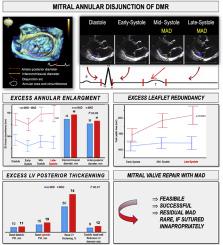Journal of the American Society of Echocardiography ( IF 6.5 ) Pub Date : 2021-09-10 , DOI: 10.1016/j.echo.2021.09.004 Benjamin Essayagh 1 , Francesca Mantovani 2 , Giovanni Benfari 3 , Joseph F Maalouf 2 , Sunil Mankad 2 , Prabin Thapa 2 , Hector I Michelena 2 , Maurice Enriquez-Sarano 2

|
Background
The dynamic consequences of mitral annular disjunction (MAD) on the mitral apparatus and the left ventricle remain unclear and are crucial in the context of mitral surgery. Thus, the aim of this study was to assess mitral valvular, annular, and ventricular dynamics in mitral valve prolapse (MVP) stratified by presence of MAD.
Methods
In 61 patients (mean age, 62 ± 11 years; 25% women) with MVP and severe mitral regurgitation undergoing mitral surgery between 2009 and 2016, valvular and annular dimensions and dynamics by two-dimensional transthoracic and three-dimensional transesophageal echocardiography and left ventricular dimensions and dynamics were analyzed stratified by presence of MAD before and after surgery.
Results
MAD (mean, 8 ± 3 mm) was diagnosed in 27 patients (44%; with a mean effective regurgitant orifice area of 0.55 ± 0.20 cm2 and similar to patients without MAD), more frequently in bileaflet prolapse (52% vs 18% in patients without MAD, P = .004), consistently involving P2 (P = .005). Patients with MAD displayed larger diastolic annular areas (mean, 1,646 ± 410 vs 1,380 ± 348 mm2), circumferences (mean, 150 ± 19 vs 137 ± 16 mm), and intercommissural diameters (mean, 48 ± 7 vs 43 ± 6 mm) compared with those without MAD (P ≤ .008 for all). Dynamically, mid- and late systolic excess intercommissural diameter, annular area, and circumference enlargement were associated with MAD (P ≤ .01 for all). MAD was also associated with dynamically annular slippage, larger prolapse volume and height (P ≤ .007), and larger leaflet area (mean, 2,053 ± 620 vs 1,692 ± 488 mm2, P = .01). Although patients with MAD compared with those without MAD showed similar ejection fractions (mean, 65 ± 5% vs 62 ± 8%, respectively, P = .10), systolic basal posterior thickness was increased in patients with MAD (mean, 19 ± 2 vs 15 ± 2 mm, P < .001), with higher systolic thickening of the basal posterior wall (mean, 74 ± 27% vs 50 ± 28%) and higher ratio of basal wall thickness to diameter (P ≤ .01 for both). However, after mitral repair, MAD disappeared, and LV diameter, wall thickness, and wall thickening showed no difference between patients with MAD and those without MAD (P ≥ .10 for all).
Conclusions
MAD in patients with MVP involves a predominant phenotype of bileaflet MVP and causes profound annular dynamic alterations with considerable expansion and excess annular enlargement in systole, potentially affecting leaflet coaptation. MAD myocardial and annular slippage simulates vigorous left ventricular function without true benefit after surgical annular suture. Thus, although MAD does not hinder the feasibility and quality of valve repair, it requires careful suture of ring to ventricular myocardium, lest it persist postoperatively.
中文翻译:

退行性二尖瓣关闭不全的二尖瓣环分离:三维评估及其对二尖瓣修复的意义
背景
二尖瓣环分离 (MAD) 对二尖瓣装置和左心室的动态影响仍不清楚,并且在二尖瓣手术中至关重要。因此,本研究的目的是评估二尖瓣脱垂 (MVP) 中的二尖瓣、瓣环和心室动力学,并根据 MAD 的存在进行分层。
方法
在 2009 年至 2016 年期间接受二尖瓣手术的 61 名 MVP 和严重二尖瓣关闭不全患者(平均年龄 62 ± 11 岁;25% 女性)中,二维经胸和三维经食管超声心动图和左心室的瓣膜和瓣环尺寸和动态根据手术前后 MAD 的存在对尺寸和动态进行分层分析。
结果
27 名患者(44%;平均有效反流口面积为 0.55 ± 0.20 cm 2且与没有 MAD 的患者相似)诊断出 MAD(平均 8 ± 3 mm),更常见于双叶脱垂(52% vs 18%在没有 MAD 的患者中,P = .004),始终涉及 P2 ( P = .005)。MAD 患者的舒张环面积(平均 1,646 ± 410 对 1,380 ± 348 mm 2)、周长(平均 150 ± 19 对 137 ± 16 mm)和关节间直径(平均 48 ± 7 vs 43 ± 6 mm)更大) 与没有 MAD 的人相比(所有P ≤ .008)。动态地,收缩中晚期关节间径、环面积和周长增大与 MAD 相关(P ≤ .01 全部)。MAD 还与动态环状滑脱、更大的脱垂体积和高度 ( P ≤ .007) 以及更大的瓣叶面积相关(平均 2,053 ± 620 对 1,692 ± 488 mm 2,P = .01)。尽管与没有 MAD 的患者相比,MAD 患者的射血分数相似(分别为 65 ± 5% 和 62 ± 8%,P = .10),但 MAD 患者的收缩期基础后部厚度增加(平均 19 ± 2 vs 15 ± 2 mm, P < .001),基底后壁收缩期增厚更高(平均,74 ± 27% vs 50 ± 28%)和基底壁厚度与直径之比更高(P ≤ .01 两者)。然而,在二尖瓣修复后,MAD 消失,LV 直径、壁厚和壁增厚显示 MAD 患者与非 MAD 患者无差异(均P ≥ .10)。
结论
MVP 患者的 MAD 涉及双叶 MVP 的主要表型,并导致显着的瓣环动态改变,收缩期显着扩张和瓣环过度扩大,可能影响瓣叶接合。MAD 心肌和环状滑脱模拟了剧烈的左心室功能,但在手术环状缝合后没有真正的益处。因此,虽然 MAD 不妨碍瓣膜修复的可行性和质量,但它需要小心地将环缝合到心室心肌,以免术后持续存在。



























 京公网安备 11010802027423号
京公网安备 11010802027423号